Brent Marchant's Blog, page 69
March 3, 2020
‘To Dust’ wrestles with expectations, obsession
“To Dust” (2018 production, 2019 release). Cast: Géza Röhrig, Matthew Broderick, Leo Heller, Ziv Zaifman, Janet Sarno, Bern Cohen, Ben Hammer, Joseph Siprut, Marceline Hugot, Isabelle Phillips, Natalie Carter, Leanne Michelle Watson. Director: Shawn Snyder. Screenplay: Jason Begue and Shawn Snyder. Web site. Trailer.
We all have expectations about how life is supposed to unfold. In fact, we may feel so confident about them that we even take them for granted. But what happens when they don’t materialize as anticipated? That can easily make us uncomfortable, perhaps even unnerved, especially when there are high emotional stakes involved. And, when that process moves forward seemingly unchecked, we may even grow obsessive about these unmet expectations. So it is for a grieving widower when he comes up against what may (or may not) be happening with his deceased spouse in the edgy dark comedy, “To Dust,” available on DVD and video on demand.
When Hasidic cantor Shmuel (Géza Röhrig) loses his wife, Rikvah (Leanne Michelle Watson), to cancer at an early age, he’s devastated. Not only has he lost his beloved, but he’s also been left to raise two young sons, Noam (Leo Heller) and Moishe (Ziv Zaifman), as a single father. However, before long, those are not his only concerns; shortly after Rikvah’s burial, he begins having vivid and disturbing dreams about her transition from the world of flesh to the world of spirit, the process by which she turns “to dust.” He subsequently grows obsessed about the process of her body’s decomposition as worrisome thoughts cross his mind – How long is it supposed to take? Is her body’s breakdown progressing as it should in terms of timing and procedure? And, above all, will it end her suffering and lead to a proper transition to the life hereafter?
Those close to Shmuel grow concerned that he’s being overly morbid about all this, that he’s even running the risk of exceeding the stringent timeline his religion allows for grieving. To cope, he consults spiritual leaders (Bern Cohen, Ben Hammer) for guidance, but their answers don’t suit his needs. So, in an effort to get past this preoccupation, Shmuel concludes that he needs to better understand how the decomposition process works, a decision that starts him down a very slippery slope.
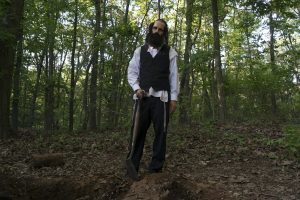
Worried that his deceased wife will transition from the world of flesh to the world of spirit on schedule, Hasidic cantor Shmuel (Géza Röhrig) becomes obsessed with understanding how the process works in the creepy but sublime dark comedy, “To Dust.” Photo courtesy of Good Deed Entertainment.
Shmuel first consults an undertaker (Joseph Siprut), who rudely dismisses the cantor once he figures out that he’s not in the market for a casket or burial services. Frustrated, Shmuel then takes an even more radical step by seeking the advice of a man of science, a potentially blasphemous move that could easily get him expelled from his religion if discovered. Nevertheless, Shmuel needs answers, and he hopes to get them from Albert (Matthew Broderick), an oft-befuddled community college biology professor.
Shmuel shows up unannounced at Albert’s college, whereupon he unassumingly walks into his classroom and asks for help. Needless to say, Albert is perplexed at the mysterious visitor’s arrival, not having a clue who Shmuel is, why he’s there or what possessed the stranger to pick him for help. But, to one unaccustomed in the ways of science, Shmuel doesn’t see any distinction among its practitioners, so, in his mind, anyone who has any knowledge of the subject will do.
However, given that Shmuel’s inquiry carries as many theological considerations as it does scientific, Albert is convinced he can’t help him (not that he really wants to anyway). Nevertheless, Shmuel is insistent, so Albert begrudgingly sits down and begins explaining how the decomposition process works, the first step in what will become a long and complicated dark comedy of errors.
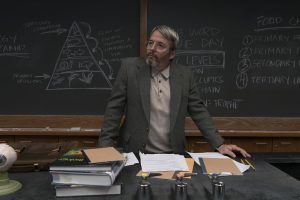
Put-upon community college biology professor Albert (Matthew Broderick) has an additional unexpected challenge to tackle when he’s approached with an unusual request from a Hasidic cantor in “To Dust.” Photo courtesy of Good Deed Entertainment.
To say more would reveal too much, but suffice it to say that this unusual collaboration sparks a strange and comically macabre series of events involving an experiment to chart the decomposition rate of (of all things) a pig, a trip to a “human decomposition farm” and regular visits to a tranquil lakeside location where the cantor believes he’s able to commune with Rikvah’s spirit. Meanwhile, as all this unfolds, others look upon Shmuel and worry, including his sons, who have become convinced he’s in cahoots with a dybbuk; his spiritual leaders, who are concerned that the cantor has become incapable of carrying out his work; and his mother, Faigy (Janet Sarno), who quietly frets that he’s not getting on with his life to find a new wife, showing little interest in the prospective mate (Isabelle Phillips) she’s arranged for him to meet. And, through all this, there’s Albert, who’s increasingly put upon by Shmuel’s requests, including questionably ethical (and potentially illegal) incidents that could threaten his livelihood, career and personal freedom.
However, as this strange odyssey plays out, events unfold that provide surprisingly revelatory insights for all concerned, especially Shmuel. Truly meaningful developments emerge from unlikely events and individuals, providing answers where previously there were none: An impromptu road trip to Tennessee from their home in upstate New York proves remarkably telling, while a chance encounter with a security guard (Natalie Carter) ends up speaking volumes of once-hidden wisdom. And, in the process, the outwardly comical turns out to be richly sublime. Indeed, for those who doubt that the Lord works in mysterious ways, these episodes turn such skepticism on its head. But, then, as long as the unanswered questions finally receive responses, does it really matter where they come from or whether they follow prescribed expectations? After the kind of journey that Shmuel and Albert experience together, they might well say that it doesn’t matter a damn.
Shmuel’s loss is indeed sad. It’s patently obvious how much he loved Rikvah, and his worries about the well-being of her soul after her passing only make that loss that much more painful. He clearly needs to find closure so that he can make peace with her death and get on with his life. But, with relentlessly obsessive thoughts racing through his head and no readily available answers, he’s being tortured by his own mind, a process that carries on and seems to have no resolution. What is he to do?

Moishe (Ziv Zaifman, left) and Noam (Leo Heller, right), the young sons of a Hasidic cantor raising them as a single father, worry that their dad may be possessed by a dybbuk when he becomes obsessed with the after-death experience of his late wife in “To Dust.” Photo courtesy of Good Deed Entertainment.
To a great degree, Shmuel is locked into these circumstances because of his beliefs, which, thanks to the philosophy of conscious creation, serve to shape the reality he experiences, for better or worse. Shmuel’s heavily bought into the beliefs of his religion, many of which follow rigidly prescribed dictates, established limitations that may – or may not – ultimately suit one’s needs or expectations. And, regardless of whether or not he genuinely believes in their validity, he’s expected to adhere to them to maintain his standing with his fellowship. But is that truly feasible?
This is not meant to denigrate one’s religion, but how can one be expected to observe such precepts if one has doubts about them? That’s the conundrum Shmuel quietly faces, especially when he begins having thoughts and dreams that prompt him to question what he’s supposed to accept without reservation. If he needs answers that his faith cannot provide, he must pursue other means to get them, and. if he cannot get past his grief in line within a stipulated timetable, then he must be allowed to give himself permission to move through that process at the pace that best suits him. And this must all happen even if it means risking his acceptance by his religious community.
At the same time, though, despite Shmuel’s courage to get answers in his own way, he still clings to many of the established beliefs he has long embraced. It’s as if he’s trying to dissect the mechanics behind these intangible notions in order to better understand them, despite prohibitions against doing so by the means he employs. He genuinely seems to want to believe in the fulfillment of the expectations he’s long believed in, even if their unfolding does not proceed according to what he has been taught to believe is supposed to happen.
Unfortunately, when faced with such seemingly conflicting circumstances, the result can be maddening, and that can lead to a perilously difficult outcome – obsession. Much of Shmuel’s behavior would seem to fit that pattern, one that grows progressively more consuming over time and that causes the concern expressed by his family and peers. And, once this sets in, it can lock one into an even more restrictive set of limiting beliefs, making escape increasingly difficult.
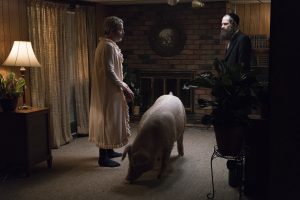
An experiment with, of all things, a pig leads to events spinning out of control for Shmuel, a Hasidic cantor (Géza Röhrig, right), and Albert, a community college biology professor (Matthew Broderick, left), in their quest to study human decomposition rates in the dark comedy, “To Dust.” Photo courtesy of Good Deed Entertainment.
Several factors contribute to this. In part, Shmuel would seem to be engaged in some heavy-duty semi-conscious creation, an approach to the manifestation process that prevents its creator from recognizing that a desired aspiration has been materialized in principle, even if it doesn’t match the form that was anticipated. If Shmuel were to examine his circumstances realistically, he would discover that the breakdown of Rivkah’s corpse is indeed following its natural course, fulfilling the ultimate expectation, even if it’s not necessarily occurring in line with postulated projections. If he were to see this for what it is, he might be able to rest more easily.
Part of the reason why Shmuel may not be able to see this has to do with the role that doubt and fear can play in thwarting the manifestation process. As conscious creators are well aware, these factors can easily undermine how materializations unfold, largely because they are belief-based notions themselves that can contradict, and subsequently interfere with, the realization of anticipated outcomes. Since Shmuel’s thoughts are riddled with doubts and fears, is it any wonder, then, that his expectations might not achieve fulfillment? And, given that, is it any surprise that this development only leads to more doubt and fear that drives the progression of his obsessive behavior? It really becomes a vicious circle.
There are ways out, though, if Shmuel is willing to consider them. Thinking outside the box to consider the formation of beliefs that surpass limitations can go a long way to overcoming this. This process can be further enhanced in additional ways, such as paying attention to the synchronicities we encounter, those meaningful “coincidences” that seem to be so perfectly tailored to our needs that they can’t realistically be taken as random chance. It can also be aided by listening to our intuition, that quiet inner voice that speaks to us seemingly out of the blue and often doesn’t make sense yet ultimately proves to be spot on. To his credit, Shmuel takes these considerations to heart during the course of his journey, such as when he notices his ability to commune with Rikvah during his visits to the tranquil lakeside locale. Such interactions offer guidance that proves useful, not only in helping him retool his beliefs, but also in coming up with helpful resolutions to his issues.
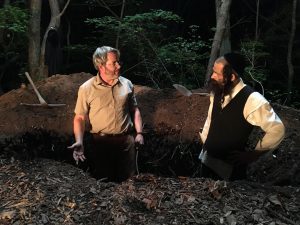
Biology professor Albert (Matthew Broderick, left) and Hasidic cantor Shmuel (Géza Röhrig, right) find themselves in an increasingly questionable spot when they begin an experiment to measure human decomposition rates in the hilariously dark comedy, “To Dust.” Photo courtesy of Good Deed Entertainment.
In the end, it’s possible to get past what holds us back, even in such matters as resolving profound grief. The process can be difficult enough to get through based just on the emotional devastation of what has happened, but it can become that much worse when we allow our minds to wander into territory that hinders resolution. But, by looking within and tapping into the beliefs driving all of this, we can at last achieve peace – and make it possible to move forward with our lives.
To be frank, some viewers may look upon “To Dust” as patently appalling or sacrilegious. Its dark humor, admittedly morose subject matter and lampooning of sacred principles might easily offend many. Indeed, there are many moments where viewers might find themselves laughing at things that they probably think they shouldn’t be chuckling about. But, in many ways, those elements are what makes this film work so effectively, especially when the humor is tinged with underlying insights that may not be apparent at first but that are quickly followed by a thoroughly pleasing aftertaste. This unlikely buddy flick grows increasingly hilarious with each passing episode, with Röhrig and Broderick serving up big, unexpected laughs that often prove deceptively profound and sweetly uplifting. This delicious little gem delivers more than what it superficially seems to offer, leaving viewers with good feelings, a warm glow, a tickled spirit and maybe even a new outlook on what comes after this life. For their efforts, screenwriters Jason Begue and Shawn Snyder earned an Independent Spirit Award nomination for their excellent, inspired script.
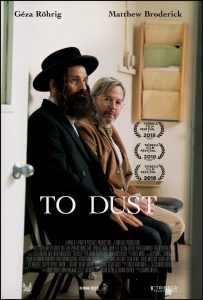
When we let our expectations get the better of us, they can eat us up more detrimentally than even the most aggressive microbes devouring a corpse. If they go unfulfilled, they can devastate us as they push us into obsessive behavior and frazzled states of mind. But we needn’t remain captives of our thoughts; we can break free and find peace of mind, provided we take the steps to do so – and as long as we take action before we turn to dust.
Copyright © 2020, by Brent Marchant. All rights reserved.
The post ‘To Dust’ wrestles with expectations, obsession appeared first on Brent Marchant.
March 2, 2020
‘Love’ on The Cinema Scribe
Tune in for the latest Cinema Scribe segment on Bring Me 2 Life Radio, Tuesday, March 3, at 2 pm ET, by clicking here. And, if you don’t hear it live, catch it later on demand!


The post ‘Love’ on The Cinema Scribe appeared first on Brent Marchant.
February 26, 2020
‘The Truth’ urges us to remove the drama from the stage of life
“The Truth” (“le Verità”) (2019 production, 2020 release). Cast: Catherine Deneuve, Juliette Binoche, Ethan Hawke, Clémentine Grenier, Manon Clavel, Roger Van Hool, Alain Libolt, Christian Crahay, Ludavigne Sagnier, Sébastien Chassange, Laurent Capelluto, Jackie Berroyer. Director Hirokazu Kore-eda. Screenplay: Hirokazu Kore-eda. Web site. Trailer.
Drama may have a place in life, but some of us have trouble determining the stage on which it’s most appropriate. Theaters and movie screens are certainly acceptable venues, but, when drama makes its presence felt on the stage of life, it may well have overstepped its bounds. That’s particularly true when it intrudes upon personal relationships, a place where its appearance may be unwanted, if not unhealthy. Such is the case in the long-tense dealings between an aging mother and her adult daughter in director Hirokazu Kore-eda’s new domestic comedy-drama, “The Truth” (“le Verità”).
Being a big screen diva is so demanding. It requires one to be constantly “on,” ever spinning the right impression to maintain that mystique but never revealing anything that could expose an unflattering image. Just ask Fabienne Dangeville (Catherine Deneuve), a 70-something award-winning grand dame of French cinema whose career is winding down but who honestly believes she’s still a big deal. And, to prove she’s still relevant, she’s just released a memoir called The Truth, a glowing treatise wrapped up in a neat, tidy package designed to portray her as being just as grand and gracious in her off-screen life as in any of her movie roles. She’s also recently accepted a supporting part in an upcoming science fiction drama in which she plays the aging daughter of a mother (Manon Clavel) who never ages and holds on to her eternal youth, a character who, coincidentally, embodies Fabienne’s view of herself.
To celebrate these developments, Fabienne receives a visit from her daughter, Lumir (Juliette Binoche), a screenwriter living in New York with her husband, Hank (Ethan Hawke), a mediocre TV actor who’s managed to attain some success now that he’s come out of rehab, and her plucky 8-year-old daughter, Charlotte (Clémentine Grenier). Mother Fabienne and daughter Lumir haven’t been especially close for a long time, largely because Madame Diva was too busy with herself to devote much time to her young one while she was growing up, often shuffling Lumir off with Sarah, a “friend” (and acting rival) who filled the role of maternal surrogate. Lumir grew fond of her caretaker, and resentful of the way her mother treated her, especially when the woman she supposedly considered a good friend died. But, lingering bitterness aside, Lumir attempts to approach her visit with as cheerful an attitude as possible.

Fabienne Dangeville (Catherine Deneuve, left), self-absorbed grand dame of French cinema, welcomes her daughter, Lumir (Juliette Binoche, right), for a visit upon the release of her mother’s long-awaited memoir in director Hirokazu Kore-eda’s “The Truth” (“le Verità”). Photo courtesy of IFC Films.
Of course, sweetness soon turns sour when Lumir begins reading excerpts from The Truth. Barbs start flying when she comments on some of the outright lies that her mother packed into the book, such as the joy she supposedly received when picking up Lumir from school every day, something she never did, a task left in Sarah’s hands. And, when Lumir confronts Fabienne about these falsehoods, mother dearest casually dismisses them, ironically contending that telling “the truth” isn’t interesting enough for her fans and readers.
As Lumir’s temper simmers, Hank does his best to help keep calm in the family, as do others on hand, such as Fabienne’s lover, Jacques (Christian Crahay), Mme. Dangeville’s often-beleaguered handler, Luc (Alain Libolt), and the diva’s ex-husband (and Lumir’s father), Pierre (Roger Van Hool), who shows up out of the blue. They try to keep the peace under increasingly trying circumstances, recurring bouts of bickering and Fabienne’s signature flippant behavior, which doesn’t stop just because her daughter has come for a visit.
When these domestic incidents aren’t going on, Fabienne is chauffeured back and forth between home and the movie set. But, as filming progresses, Fabienne finds herself growing progressively anguished and uncomfortable. That’s because, although the movie she’s making has a sci-fi premise, its narrative is uncharacteristically sophisticated for this genre in that it’s also an intense mother-daughter drama. And, as the daughter character in this production, Fabienne starts to gain insights into her real-life daughter’s feelings – probably for the very first time. Through her portrayal of a child of an often-absent mother, Fabienne at last begins to appreciate much of what Lumir endured during her upbringing, an unsettling eye-opener. She begins to see how old hurts can linger on into adulthood, well past the time when many might contend that they should be forgotten and overcome.

On her way to work, award-winning film actress Fabienne Dangeville (Catherine Deneuve) readies to play a role that comes uncomfortably close to paralleling her off-screen life in “The Truth” (“le Verità”). Photo courtesy of IFC Films.
Meanwhile, as Lumir stews over what she sees as her mother’s continuing lack of care and concern, she learns through conversations with Fabienne’s familiars that some of her recollections are erroneous, that a number of her supposed childhood memories are just plain wrong. There may indeed have been times when Lumir rightfully felt ignored, but not for all of the occasions in her inventory of alleged slights. The bitterness that she built up over certain supposed snubs may have grown so vastly out of proportion that it spilled over into events that just didn’t play out the way she thought she remembered them. And, as with Fabienne’s new realizations about herself, the same becomes true for Lumir.
With these insights, one might naturally think that they ought to open the door for all kinds of schmaltzy reconciliations and a bevy of Hallmark moments. But do they? Is it possible that self-absorbed self-importance might cut both ways? And how much impact might that have as mother and daughter approach one another with new understandings of themselves and their feelings toward the other? Well, that remains to be seen, especially now that each must grow comfortable with their own revised versions of “the truth.”
To casual observers, rocky scenarios like this may prompt some to scratch their heads and wonder how they could have come about. Those who value harmonious family relations may find these kinds of situations completely unnecessary, circumstances manufactured out of needless drama blown all out of proportion. But, for those whose vocations incorporate drama as an integral element – like actresses and screenwriters – is it any surprise that this quality of their working lives might spill over into the personal side of life? In fact, as many movies, books and plays have illustrated through the years, real-life experiences (including those of a domestic nature) frequently feed the imagination of their creators. So, realistically speaking, why should Fabienne and Lumir be any different?
This is not to suggest that mother and daughter necessarily birthed their difficulties purely for career reasons, but their personal experiences probably didn’t hurt in helping them hone their craft. Their passion for their work and their resolute conviction in their abilities as artists undoubtedly helped draw them to circumstances capable of aiding them develop professionally. And, upon recognizing this, it’s entirely possible that they came to believe in what this could do for them, notions that subsequently manifested as experiences that fueled their art – and lives.
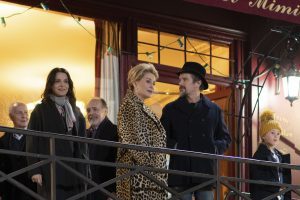
While out for a night on the town in Paris, actress Fabienne Dangeville (Catherine Deneuve, second from left, foreground) is joined by her daughter, Lumir (Juliette Binoche, left, foreground), son-in-law, Hank (Ethan Hawke, second from right, foreground), and granddaughter, Charlotte (Clémentine Grenier, right, foreground), in “The Truth” (“le Verità”). Photo courtesy of IFC Films.
However, as this film illustrates, such situations come with their share of difficulties once materialized. Which is why it’s important to pay attention to the beliefs that give rise to them. As products of the conscious creation process, the philosophy that maintains we draw upon our thoughts, beliefs and intents to realize the world around us, these scenarios show us how powerful those metaphysical building blocks can be and the degree of care we must exercise in how we employ them. They may give us what we need in one sense, but they may also be fraught with other qualities that make life difficult in many other ways. That’s an assessment to which I’m sure Fabienne and Lumir can attest.
If it’s not already obvious, this film demonstrates how our beliefs truly require kid gloves treatment. If we’re cavalier, derelict or unconcerned in our handling of them, we can wreak tremendous havoc on ourselves and those around us. That practice may make for good drama – and effective fodder for writers and actors – but it can also create all manner of problems outside of this context. That’s why we need to take our beliefs seriously in light of what they can create.
This is important not only in recognizing the impact of our beliefs, but also in weighing the accuracy of our assessments (and recollections) of what they ultimately manifest. For Fabienne, the former is certainly an issue, given her often-capricious, frequently oblivious behavior. Meanwhile, the latter is a problem for Lumir in light of her fallible memory. Both of these matters create problems for individuals who aren’t as diligent as they should be, not only for themselves, but also for those around them. Conditions like these may make for good drama but not good relationships.
All is not lost, though, because we can use our beliefs to institute corrective measures (even if we don’t necessarily recognize those solutions as such). Given the long-smoldering discord between mother and daughter, it’s a safe bet that they may finally be ready to reconcile, and that becomes apparent through some of the measures they unwittingly implement to break the stalemate. Fabienne, for example, takes a movie role that gives her insight into Lumir’s feelings, providing an understanding of her daughter’s emotions that she never had before. Likewise, Lumir engages in conversations with those who point out the fallibility of her recollections, making her aware of false memories that she had been holding onto erroneously for decades. In both cases, they may not initially realize the significance of these measures, but, when their underlying intent becomes apparent, it’s obvious why they’ve drawn them into their existence.

Hopes for a happy reunion get tested when actress Fabienne Dangeville (Catherine Deneuve, second from right) welcomes her daughter, Lumir (Juliette Binoche, second from left), son-in-law, Hank (Ethan Hawke, left), and granddaughter, Charlotte (Clémentine Grenier, right), in the new domestic comedy-drama, “The Truth” (“le Verità”). Photo courtesy of IFC Films.
This, of course, spotlights the value of redemption that conscious creation makes possible. Indeed, it’s never too late to make amends, but, as the clock begins to run out, the urgency behind this may get turned up a few notches. It’s something we can implement whenever we want, provided we’re willing to do so.
Making that happen requires that we be honest and sincere with ourselves, that we’re willing to operate from a position of personal integrity. Without that, any efforts we undertake will likely produce only mixed results at best. Given the longstanding mistrust between Fabienne and Lumir, it may be easy to see why this is a quality that doesn’t come easy for either of them. However, if they hope to make things work, they had better decide whether or not they want to get serious about this. We can only hope the best for them.
Director Hirokazu Kore-eda’s first foray into filmmaking outside of his native Japan tells a tale in some ways similar to, and in other ways quite different from, his previous projects. The narrative here recalls Ingmar Bergman’s “Autumn Sonata” (1978) as an adult mother and daughter come to terms with their past in determining what kind of future they would like to forge. Deneuve gives a command performance, award-worthy for sure, and the script is full of ample, laugh-out-loud wit. The pacing in the final act could use some shoring up, but this otherwise-delightful, often-touching offering is worth the time. “The Truth” has primarily been playing at film festivals, but it will receive a general release in late March.
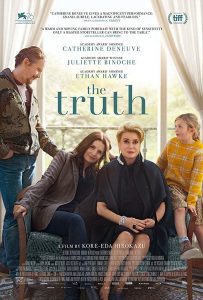
Getting at “the truth” may prove to be a trickier proposition than meets the eye. Because we each hold our own view of events, our perspectives may be tinged by feelings that affect the beliefs that create those perceptions. This, in turn, can open the door for subjectivity and differing interpretations to enter the picture, elements that can become stepping stones to drama and conflict. Sorting out matters when they reach this point can become increasingly problematic, to be sure, but nothing is beyond resolution if we remember what it is we’re seeking in the first place – and take the necessary steps to bring that into being.
Copyright © 2019-20, by Brent Marchant. All rights reserved.
The post ‘The Truth’ urges us to remove the drama from the stage of life appeared first on Brent Marchant.
February 25, 2020
This Week in Movies with Meaning
Reviews of “Ordinary Love,” “Knives and Skin” and “The Hottest August,” as well as an Oscar scorecard, are all in the latest Movies with Meaning post on the web site of The Good Media Network, available by clicking here.





The post This Week in Movies with Meaning appeared first on Brent Marchant.
February 24, 2020
‘The Hottest August’ showcases how to survey the bigger picture
“The Hottest August” (2019). Cast: Clare Coulter (narrator). Director: Brett Story. Web site. Trailer.
What does the future hold? That’s a question many of us ask ourselves often, both individually and collectively. But how wide a view do we take when answering it, again, either individually or collectively? That’s a subject addressed in the experimental new documentary, “The Hottest August.”
It probably doesn’t come as much of a surprise that, when we contemplate the future, we usually do so in terms of how it most directly affects us as individuals or in our peer groups. We think about our homes, our families, our communities, our professions and so forth, the aspects of our lives that have the most immediate impact. We consider what lies ahead for each of these areas of our lives and speculate what shapes they might take and what qualities they could possess. And that’s not unexpected; after all, all of us have a vested stake in the outcome.
But how often do we ponder the future of areas outside of our immediate field of impact? A communications worker, for example, might ruminate about the future of his or her industry and the technology associated with it, but how readily would said professional think about global economics or the state of the environment? How likely is a low-income laborer to examine the effect that the prices of commodities futures have on the portfolios of the one-percenters? Does the extinction of an insect species in Africa affect the lives of Midwestern housewives?
Some of these questions may seem silly, perhaps even absurd. However, if we live in a truly interconnected reality, such queries may be more relevant than initially meets the eye. For instance, who would have thought that a hurricane in Florida could lead to the collapse of a publishing venture in Chicago and the layoff of its staff (a scenario I can speak to personally)? Thus, examining our world and its future from a holistic standpoint is more important than many of us might believe.

Are environmental suits in our future? That’s one of the questions raised in the experimental new documentary, “The Hottest August.” Photo courtesy of Grasshopper Film.
In “The Hottest August,” director Brett Story attempts to do this in a way that probably hasn’t been tried before. Through interviews with everyday individuals in the greater New York City area, representing all ages, races, and cultural, economic and social backgrounds, he asks them what they foresee for the future, be it on the macro level or personally. And their responses are quite revealing in terms of how they view the world, its challenges and their place in it all.
Since the world is an interconnected place, as the film contends, the challenges it faces realistically can’t be looked at in a vacuum; they need to be addressed from an integrated perspective. Yet, based on the answers of the interviewees, it’s quite telling how many of them view the world from such tightly focused, single-minded outlooks. Their answers reflect the concerns that impact them the most, with minimal to modest consideration for what’s outside their immediate existence, such matters essentially being treated as if they’re on the “periphery” of their lives (when, in fact, they’re just as much a part of their reality as the elements that affect them most directly, even if not as much or as often).
This is not to suggest short-sightedness or closed minds on their part; it merely demonstrates how many of these individuals have allowed themselves to become accustomed to thinking along those lines. They may not be unconcerned about the aspects of their existence that are outside of their immediate purview; rather, this is more likely a case of them just having never given them much thought, simply because of the way they think (and how they were taught to do so). However, given the issues the world is facing today, such a limited view can’t be allowed to continue. A more inclusive outlook must be put into place – and, as the occupants of this reality, that has to start with us.
Since existence is not something that we deal with on a compartmentalized basis, we shouldn’t expect that we can solve its problems using such an approach. Given that all of the components of reality are inherently intermingled, we must thus employ an integrated approach to solving their problems. The environment, for example, cannot be remedied without considering the economics involved, which, in turn, may affect consumer product development, which, in turn, may affect everyday lifestyle choices…and so on, and so on, and so on.

Will the wildlife we know today still be around tomorrow? Filmmaker Brett story asks that in the experimental new documentary, “The Hottest August.” Photo courtesy of Grasshopper Film.
But how do we go about this? It has to do with our beliefs, for they shape the reality we experience through the conscious creation process, the philosophy that maintains we draw upon them in manifesting our existence. In this case, however, it requires us to take a broader view than we typically have when it comes to the development of our beliefs. For instance, from this perspective, to build a better mousetrap, we must go beyond merely devising beliefs for coming up with the schematics. We must instead formulate beliefs that consider the need for such a device, the materials from which it’s constructed, the economics behind its production, and the impact on the environment, the mice and our relationship to them. In short, this calls for us to look at how we form manifesting beliefs from the standpoint of the overall bigger picture of our existence. And that’s essentially what this film is all about.
In many regards, this picture is aimed at showing us how to shift our thinking in the formation of one of our “core beliefs,” one upon which all others rest. Think of this as the metaphysical equivalent of a computer operating system, one upon which all of the “application program” beliefs run. In essence, making this shift calls for a whole new way of developing the beliefs that emerge from this underlying template. Such an approach pushes us to devise new manifestations based on beliefs that incorporate the principles of the core notion automatically, qualities that are built in up front so that they’re taken as givens from the outset. Beliefs that don’t take such considerations into account from the very beginning simply don’t gain any traction – nor do they have a realistic chance of even coming into being.
This new way of thinking may take some time to become accepted and put into use. However, once we begin doing so routinely, we may well look back and wonder why we weren’t employing this practice all along. One of the hardest parts in this, though, is making individuals and communities aware of this principle and encouraging them to put it into use on a regular basis. Again, that’s what this film attempts to show us. It exposes us to many of the components we need to consider and subtly nudges us in the direction of looking for ways to integrate them with one another through a holistic, inclusive approach.
Since we’re new at this, we probably shouldn’t expect overnight success. But at least taking those very first baby steps is a move in the right direction. The more confident we grow at this, the more this will seem like second nature, something that will likely be reflected in the results we experience. And, like a muscle that grows stronger with greater use, so, too, will our proficiency in this approach to the conscious creation process. The pieces will start to fall into place more readily and transform the nature of the elements of the reality we experience.
Or at least that’s what we like to hope for. We could just as easily stay myopic and continue to plunge headlong deeper into the problems we’re experiencing, depending on what beliefs and outlooks we embrace. That’s a potentially scary prospect, and it’s one that’s raised in the course of the film. Will we heed the warning?

What kind of climate does the future hold, and how will it impact activities we take for granted? Such integrated questions are among those raised in the experimental new documentary, “The Hottest August.” Photo courtesy of Grasshopper Film.
On the other hand, the film shows us examples of individuals who are beginning to move in the direction of taking a wider view. We can hope that their perspectives catch fire and that others follow their lead. That’s the other side of the coin – and the one that we should hope flips in our favor.
Depicting both perspectives shows us where we’re at as a species. And that’s one of the other aims of this film. By presenting us with a cinematic view of the world in one locale (greater New York) during one particular period (the month of August 2017), we get to see the kaleidoscopic panorama of our existence and its many components – as well as the many resources we have available to us to draw upon in shaping our existence as we move forward. The question is, what will we choose?
No matter how we ultimately proceed, we’ve got to start somewhere, and “The Hottest August” presents us with a poetic and inclusive illustration of this idea. It doesn’t tell us what to do, but it certainly shows us by way of example what we can do if we put our minds to it. The question here, of course, is “Are we astute enough to recognize the message being sent our way?” I’d like to believe the director thinks so (or at least hopes so), an aspiration to which I’d heartily lend my support and encouragement as well.
In the meantime, the film reminds us, we all have to remember to live our lives. We may have ongoing challenges to address, but we also have the daily aspects of everyday living to contend with, the things that sustain us, give us joy and provide us with meaning for living. We mustn’t lose sight of those activities as we tackle the bigger questions, as they’re part of what makes life and the human experience worth living. It’s a lot to take in, to be sure, but then that comes with the territory as we examine and assess the bigger picture of our existence.

While the tone of “The Hottest August” is decidedly experimental and the narrative definitely defies categorization, this unconventional documentary attempts to provide an integrated look at our existence, one that seeks to reconcile our present with what could be our future at a time that’s a crucial crossroad of change on many fronts – socially, politically, economically and environmentally, to name a few – and the impact of that amalgamation of influences on everyday individuals, both personally and collectively. By combining impromptu, unscripted interviews with everyday Gothamites and footage of ordinary daily events and happenings of global significance (most notably the August 2017 solar eclipse), director Brett Story attempts to assemble a holistic package that illustrates the interconnectedness of all these elements and how to deal with them, both now and down the road, a tall order for sure. While the film is not entirely successful at its task (it’s sometimes a bit too random and meandering in its approach), the filmmaker’s obviously sincere attempt to show how the coalescence of these many factors influence us as individuals and as a species is nevertheless commendable, achieving something that other directors have sought to attain but not nearly as effectively or poetically as is the case here. Check the film’s web site for screenings.
“The Hottest August” is indeed an important film, one to be admired on multiple levels and one that’s capable of both inspiring and terrifying us at the same time. Indeed, if ever there were a film that shows how we’re experiencing the ancient Chinese proverb of “living in interesting times,” this would be it. May our wisdom be up to the challenge.
Copyright © 2020, by Brent Marchant. All rights reserved.
The post ‘The Hottest August’ showcases how to survey the bigger picture appeared first on Brent Marchant.
February 21, 2020
‘Knives and Skin’ charts the slow journey out of dysfunction
“Knives and Skin” (2019). Cast: Marika Engelhardt, Raven Whitley, Tim Hopper, Audrey Francis, Marilyn Dodds Frank, Grace Smith, Ty Olwin, James Vincent Meredith, Kate Arrington, Robert T. Cunningham, Kayla Carter, Alex Moss, Jalen Gilbert, Tony Fitzpatrick, Genevieve Venjohnson, Aurora Real De Asua, Ireon Roach, Haley Bolithon. Director: Jennifer Reeder. Screenplay: Jennifer Reeder. Web site. Trailer.
When we feel like we’re stuck in a rut, escape seems almost unfathomable. And, the greater the dysfunction associated with that condition, the more onerous the circumstances become. But such conditions need not be an irrevocable sentence, especially if we can find it within us to search for a way forward. These are the challenges of a group of adult and teen residents in a seemingly idyllic setting in the offbeat and arguably indescribable new offering, “Knives and Skin.”

Life is a struggle of quiet desperation in a fictional community located somewhere in the assumed wholesome Midwestern confines of suburban Illinois, a place where everything should be perfect, uncannily resembling the set design of a 1950s TV sitcom. But that mythical idealized image couldn’t be further from the truth. In fact, in many ways, this nameless locale is dysfunction personified. Consider the lives of some of its inhabitants:
Dan Kitzmiller (Tim Hopper), recently laid off from his job, is trapped in a bad marriage to his neurotic wife, Lynn (Audrey Francis), an ultra-sensitive intuitive who’s obsessed with seemingly every type of New Age fad and propped up on a cocktail of prescription meds, a combination that leads to a questionable connection to reality. She looks on her husband with contempt, given that he’s a bad provider for the family and more concerned with becoming a full-time party clown, an occupation that generates only a paltry income. She’s also certain he’s having an affair, and, thanks to her intuitive abilities, she has a pretty good idea with whom. Her various conditions and neuroses, meanwhile, don’t make her much of a homemaker, a task that’s left to her live-in mother-in-law, Miriam (Marilyn Dodds Frank), a rambunctious senior who’s got quite a thing for pot and freewheeling sexuality. Grandma’s left in charge of the family’s two teenage kids, Joanna (Grace Smith), who makes a fortune selling her mother’s dirty underwear to the high school’s lecherous principal (Tony Fitzpatrick) while fending off the advances of a substitute teacher (Alex Moss), and Andy (Ty Olwin), an oversexed jock known for inappropriate behavior with the girls he dates. It’s quite a household.
Sheriff Doug Darlington (James Vincent Meredith) and his wife, Renee (Kate Arrington), are expecting their third child. It should be a happy occasion for the long-married interracial couple, yet Doug seems less than thrilled, much to the dismay of his spouse, who’s ever chipper and bounces around like the perpetually ebullient Nora from Henrik Ibsen’s A Doll House. And, like the character whom she emulates, Renee has secrets of her own – but they’re potentially more damaging than anything Nora ever tried to conceal. Meanwhile, the couple’s two teenage children look on in bewilderment, Jesse (Robert T. Cunningham), who can’t wait to get out of town and move on with his life, and Laurel (Kayla Carter), who, because of Renee’s issues, reluctantly becomes a sort of surrogate mother for the family – and often has to bring her wayward mom back down to earth.
The girls at the local high school struggle with coming of age issues, including everything from sexuality to asserting their personal power, especially in their relationships with boys and older men. This includes not only Joanna and Laurel, but also their friends April Martinez (Aurora Real De Asua), Charlotte Kurtich (Ireon Roach) and Afra Siddiqui (Haley Bolithon). While they generally hold their own well, it can be a challenge, especially in dealings with the school’s persistently randy athletes and in situations where they openly seek to explore alternate forms of sexuality.
High school choral instructor Lisa Harper (Marika Engelhardt) lives on the edge of reality. The single mother has an unusual relationship with her daughter, Carolyn (Raven Whitley), an enigmatic teen who looks like a walking anachronism, frequently dressing like something out of decades past. Interestingly, Lisa seems to both love and envy her daughter, making for motivations and actions that are often hard to decipher. And, when Carolyn goes missing, Lisa becomes even more unhinged, engaging in progressively stranger and more unpredictable behavior. However, she also senses what may have happened to her daughter, a disappearance that came on the heels of a date with Andy Kitzmiller, a rendezvous that, curiously, Lisa knew nothing about at the time.

The mysterious disappearance of enigmatic teen Carolyn Harper (Raven Whitley) brings together the various members of a community afflicted by widespread dysfunctionality as seen in the unusual new release, “Knives and Skin.” Photo courtesy of IFC Midnight.
From the foregoing descriptions, it would seem that all of the characters in this community are terribly, terribly lost, with no clue how to get themselves or their lives on track. In fact, about the only thing they have in common is Carolyn’s disappearance, something in which they all become involved to one degree or another at some point. But, while the search for their missing friend and relative may give them some sense of purpose, they still need direction to get on with their lives and to rid themselves of the undermining behavior that’s holding them back – or sending them down potentially self-destructive paths.
Fixing that is easier said than done, however, since they all seem clueless when it comes to figuring out what’s wrong and how to go about correcting it. They almost seem fatalistic, resigned to bleak destinies without purpose, promise or direction. In short, they don’t seem to believe in anything. And, without beliefs, there’s nothing to base their reality upon, as practitioners of the conscious creation process know all too well. Given that this philosophy maintains we draw upon such notions to shape our existence, in this case, figuratively speaking, there’s nothing to manifest, because there’s nothing to work with in the first place.
How sad it is that the characters in this film are without hope. That’s mainly because they’ve come to assume they don’t have any choice in their circumstances. But, given that conscious creation can help to make virtually anything possible, that’s not true, as long as they form and embrace the right beliefs to make such outcomes possible. Indeed, as long as they can get a grip on that idea, they can begin to move forward into a new (and, one would hope, better) future.

The members of a small Illinois community (from left, Haley Bolithon, Kayla Carter, Aurora Real De Asua, Grace Smith, Ty Olwin and Tim Hopper) join forces to search for a mysteriously disappeared teen in “Knives and Skin.” Photo courtesy of IFC Midnight.
As the film progresses, the teens and adults seem to be latching on to this notion, even if only tentatively. Viewers are reminded of this in one scene where Jesse Darlington, the teen who wants to get out of town so he can get on with his life, makes a desperate plea for this from the rooftop of his high school. The school’s faculty and his friends are worried that he’s about to commit suicide, but he reassures them that’s not the case, that he’s up on the roof so he can see beyond his current circumstances, a gesture that reassures him that there’s hope for his future, one set in a different time and place. This might seem like a simple and obvious observation, but, for someone who has been trapped by limiting and unfulfilling circumstances, this could come as quite a revelation, one that moves him closer to forging and implementing new beliefs to manifest a more satisfying existence.
Realizing that we do possess the power of choice, that we can manifest what we want when we put our mind to it, can be an eye-opening experience, especially for the impressionable. For the women in this film, for example, they begin to see brighter futures for themselves when they tap into their personal power, realizing that they needn’t settle for what they’ve been led to believe they’ve been saddled with, especially in situations where insistent men try to steamroll over them. In many ways, one could say this is a feminist manifesto embedded within the larger story (or, some might even say, a feminist manifesto complemented by atypical story threads). Either way, this is further evidence that we can change our conditions when we put our minds to it, as long as we give ourselves permission to do so.

Teen Samaritans Laurel Darlington (Kayla Carter, left), Joanna Kitzmiller (Grace Smith, second from left) and Charlotte Kurtich (Ireon Roach, second from right) offer comfort to Lisa Harper (Marika Engelhardt, right) when the single mother’s teen daughter goes missing in “Knives and Skin.” Photo courtesy of IFC Midnight.
Of course, it helps tremendously if we believe in our ability to achieve this, a belief built on faith, hope and confidence that we can succeed in our efforts. It means galvanizing our resolve to surmount the prevailing challenges. It means getting serious about what we’re seeking to attempt. And it means being willing and courageous enough to eliminate self-destructive behaviors and to rid ourselves of people, things and situations that no longer serve us; the future is not set in stone, so neither should any of these things be. By embracing such a perspective, we just might get that brighter future after all.
And then there’s the enigmatic Carolyn and her mysterious disappearance. Did she die? Did she leave town without word? Is she in hiding in a secluded place? Or did she just somehow vanish into the ether, never to return? From what little we see of her in the film, it would appear that she’s not happy with her life, either, and that she somehow takes drastic, if cryptic, steps to change that and move on to something else. Her “example” thus serves as a sort of catalyst for the others, prompting them into thinking “If she can do it, maybe I can, too,” regardless of whether or not the mystery of her disappearance is ever solved. It could be seen as a case where the outcome is ultimately more important than the means by which she operated to achieve it, something that others might be able to draw inspiration from as they seek to change their lives as well. And, given what goes on in this town, goodness knows virtually everybody could benefit from that.

Spaced-out housewife Lynn Kitzmiller (Audrey Francis, left) is shocked to learn about the unusual money-making practice of her daughter, Joanna (Grace Smith, right), in director Jennifer Reeder’s new offbeat offering, “Knives and Skin.” Photo courtesy of IFC Midnight.
Although somewhat meandering at times, “Knives and Skin” is a refreshingly experimental, eloquently metaphorical, profoundly poetic look at the joys and challenges of coming of age in a pervasively dysfunctional world, presenting a truly original story unlike anything most viewers have probably ever seen. With tips of the hat to the likes of filmmakers David Lynch, Paul Thomas Anderson and John Hughes, as well as nods to such movies as “Heathers” (1989), “Carrie” (1976) and “Donnie Darko” (2001), director Jennifer Reeder serves up a frequently absurd, often hilarious, but sincerely heartfelt tale about a community of lost souls. It’s part thriller, part horror flick, part coming of age story, part cinema noir and part campy romp, all tinged with strokes of the surreal thrown in for good measure. Exquisitely shot with inventive lighting, striking cinematography, and a production design lavishly peppered with neon and pastels, these elements perfectly complement its razor-sharp script and an atmospheric soundtrack that consists mostly of beautifully performed choral versions of pop songs from the likes of New Order, Cyndi Lauper and the Go-Gos. Admittedly, this offering isn’t for everyone, but it surely gives everybody much to ponder – not to mention an undeniable desire to want to watch it multiple times.
“Knives and Skin” played primarily at film festivals, where it received numerous award nominations, as well as a few wins. It also had a brief theatrical run last fall. Currently, it’s available for streaming on Amazon, with a DVD and Blu-ray disc release scheduled for the near future.

Teens Charlotte Kurtich (Ireon Roach, left), Joanna Kitzmiller (Grace Smith, center) and Laurel Darlington (Kayla Carter, right) seek to take back their personal power when confronted by obnoxious oversexed jocks in the quirky new release, “Knives and Skin.” Photo courtesy of IFC Midnight.
When life seems patently dysfunctional, we may wonder whether things will ever be “normal.” But what becomes “normal” ultimately depends on us and what we seek to manifest for ourselves. Admittedly, it may take us some time to sort it all out, especially when it comes to figuring out the questions related to choice and change. Nevertheless, we’re not irretrievably locked into anything – including dysfunction.
Copyright © 2019-20, by Brent Marchant. All rights reserved.
The post ‘Knives and Skin’ charts the slow journey out of dysfunction appeared first on Brent Marchant.
February 19, 2020
‘Ordinary Love’ proves there’s nothing ordinary about it
“Ordinary Love” (2019 production, 2020 release). Cast: Liam Neeson, Lesley Manville, David Wilmot, Amit Shah, Melanie Clark Pullen, Esh Alladi. Directors: Lisa Barrows D’Sa and Glenn Leyburn. Screenplay: Owen McCafferty. Web site. Trailer.
“Love” is a word we often bandy about rather casually without really giving much thought to what’s behind it. That can be unfortunate, since such a practice frequently sells it short, giving us a diminished perspective on what it actually can do. Fortunately, there are tales out there that shed a bright light on the subject, showing us what it can achieve when employed skillfully and deliberately. So it is with the new touching romantic drama, “Ordinary Love.”
Middle-aged couple Tom (Liam Neeson) and Joan (Lesley Manville) have been happily married for a long time. Through the years, the couple from the suburbs of Belfast, Northern Ireland has shared many joys, as well as some sorrows, such as the tragic death of their only child, Debbie. But, much of the time, they’ve happily gone about their everyday lives with a mixture of reliable routines, playful banter and undeniable love, the kind that has fostered a strong relationship and enabled them to weather the storms of their lives. They’ve indeed built quite a satisfying life together.
Which is why it’s so disturbing when events arise that threaten to take away that happiness. While conducting a routine breast screening exam, Joan discovers an abnormality. And, when she subsequently consults her physician (Esh Alladi) and a specialist (Melanie Clark Pullen) about the matter, she’s diagnosed with cancer. The safe, secure, generally ordeal-free life they’ve built together suddenly seems perilously in danger.

The common, everyday routine of long-married couple Tom (Liam Neeson, left) and Joan (Lesley Manville, right) threatens to be seriously disrupted by a serious health issue in the touching new romantic drama, “Ordinary Love.” Photo courtesy of Bleecker Street.
With a prognosis that’s neither completely optimistic nor totally damning, and with her life at stake, Joan goes forward with her treatment program, which begins with surgery followed by chemotherapy. She endeavors to remain upbeat, but the difficulties she endures – post-surgical pain, as well as all of the side effects of chemo treatment (hair loss, incessant nausea, etc.) – take their toll on her. And, before long, they begin to take their toll on their relationship, too.
Tom wrestles with wanting to help, even though there is little he can do other than offer comfort and support. And, no matter how compassionate and reassuring he tries to be, he can never really fully appreciate what Joan is going through. She tries to spare his feelings and show gratitude for his attempts at easing her burden, yet she also knows that his well-meaning efforts are ultimately inadequate for her particular needs. In many ways, she feels alone, with no one – not even Tom – being fully able to understand what she’s undergoing.
At the same time, Tom feels alone, too. He experiences feelings of being shut out, upset that he’s seen as not being up to the task of providing adequate care (if there even is something such as that under circumstances as trying as these). He’s also frightened of the prospect of being alone permanently; with his daughter deceased and his wife’s future uncertain, he faces the very real possibility of being by himself.

Long-married couple Tom (Liam Neeson, left) and Joan (Lesley Manville, right) lead a happy life together until a serious health scare impinges on their happiness as seen in the new romantic drama, “Ordinary Love.” Photo by Aidan Monaghan, courtesy of Bleecker Street.
As Joan moves through her personal odyssey, she at last meets someone to whom she can relate, Peter (David Wilmot), a fellow cancer patient who was once one of Debbie’s school teachers. Spending time in the company of a kindred spirit gives her comfort, support and hope, especially now that she has an opportunity to share her thoughts with somebody who can fully relate to what she’s going through. Their conversations not only allow her talk about the particulars of her illness, but they also provide her with a sounding board to talk about her relationship, especially given that Peter is experiencing similar challenges with his partner, Steve (Amit Shah). And, with Peter’s health failing fast, these circumstances also give Joan pause to contemplate her own fate, to get her own thoughts in order in the face of an uncertain future.
Even with such difficulties, though, Tom and Joan nevertheless have their undying love for one another to help them get through this ordeal. While there may be times when their love is tested or when they may lose sight of it, it’s always present and available in ample supply, and they can always tap into it when the need arises. It proves to be quite the rock on which to rest their burdens and give them stability when needed. But, most of all, it provides them hope for what lies ahead, the kind of solace they can use in times like this, both for themselves and one another.
How we view our circumstances – and what we foresee for our future – may not be easy propositions to address. But, in the end, they always come down to a matter of our beliefs – what do we think about where we are and where we’re going? Is our situation something we can handle? Or is it something that we view as being beyond us, out of our control? In any case, it comes down to what we believe, and that’s important to remember, for our beliefs serve to shape our reality through the conscious creation process, the philosophy that maintains we draw upon them for this purpose.
“Ordinary Love” presents the story of ordinary people facing extraordinary circumstances, the big cosmic questions mankind has wrestled with throughout eternity. That may not seem so unusual, since all of us will face these issues for ourselves at some point. Nevertheless, that certainty doesn’t make the process any easier, especially for those who may have never given these questions much thought in the course of their everyday lives. That’s the challenge Tom and Joan are staring down now.

Not even ill health can keep Tom (Liam Neeson, left) and Joan (Lesley Manville, right) apart in the touching new romantic drama, “Ordinary Love.” Photo courtesy of Bleecker Street.
To be sure, they did face a crisis not unlike this with the death of their daughter. But, when the question looks at us squarely in the face, the impact is felt that much more strongly. And now the happily married couple – particularly Joan – must do so for themselves. So what are they going to do?
Given Joan’s prognosis, this is a scenario where it seems that “hope for the best but prepare for the worst” would likely seem most advisable. It’s an approach infused with optimism and realism at the same time, a practical outlook that gives hope but doesn’t falsely rely on wishful thinking. It requires walking a belief tightrope, one that may not be easy to traverse. But it does help to make the best of a troubling and trying situation.
Of course, one might ask why someone would create such circumstances in the first place. If it’s so awful, why manifest it? Those are indeed good questions, but it’s not our place to question the creator’s reasons; there may well be life lessons that Tom and Joan need to get that they can only learn through adversity like this. Despite its trying effects, serious illness can often be a great teacher, especially when it comes to those aforementioned big cosmic questions of life. Going through an ordeal like this often provides us with new insights into existence and the human condition, things that we might not be able to learn and appreciate in the course of a mundane ordinary routine.
In many respects, this is where the belief in hope seriously comes into play. It gives us the strength to carry on, to move forward into the abyss of difficulty and to stay the course as we work our way through these travails. It’s often aided significantly by a belief in faith, a powerful motivator that assures us whatever we endure will serve our greater good. And, when combined with hope, this belief duo makes for a powerful tool in the face of hardship.
Perhaps the strongest belief to possess in a situation like this is one’s belief in the power of love, especially when it’s employed in a co-created context, as it is here. When we make use of it on an individual basis, it can be a powerful force for our benefit and well-being. But, when it’s amplified through a joint initiative, its impact can be tremendous, especially when focused on a mutually sought-after goal. Despite their occasional disagreements, Tom and Joan are largely on the same page in this undertaking, and with their shared beliefs working in tandem, there’s no telling what they might be able to achieve.

“Ordinary Love” may seem a somewhat odd choice for a Valentine’s Day release, but, for a holiday all about love, it’s hard to imagine a more fitting offering when it comes to a film aimed at examining the profound depths of this subject. Directors Lisa Barrows D’Sa and Glenn Leyburn present a moving, exceedingly touching experience much in the style of filmmaker Mike Leigh, one that evokes genuine, heartfelt emotions throughout. This sensitive, highly personal look at what a cancer diagnosis does shows just how affecting the impact can be on anyone, but especially to a longtime married couple. It’s a fairly simple, straightforward story, one that’s been done a number of times before, but it presents the narrative in exacting detail yet with an extraordinarily everyday approach, one that illustrates how life goes on (or attempts to go on) even in the face of exceptional (and burdensome) circumstances. The picture’s excellent award-worthy performances by Neeson and, especially, Manville, along with simple but effective cinematography, a meticulous production design and a suitably fitting soundtrack, elevate a familiar narrative to an entirely new level of frankness and viewer intimacy.
When circumstances look bleak, we’re indeed fortunate to have love to fall back on. It offers us hope, comfort and support in the face of dire conditions, even when they seem irreconcilable. It shepherds us through our difficulties and leads us to a place of consolation, perhaps even a deeper understanding of ourselves and our existence. But, above all, it can work miracles, even in the most demanding situations. That’s quite an accomplishment for a little four-letter word – but one that embodies remarkable qualities beyond measure.
Copyright © 2019-20, by Brent Marchant. All rights reserved.
The post ‘Ordinary Love’ proves there’s nothing ordinary about it appeared first on Brent Marchant.
February 17, 2020
An Oscar Winner on The Cinema Scribe
Tune in for the latest Cinema Scribe segment on Bring Me 2 Life Radio, Tuesday, February 18, at 2 pm ET, available by clicking here. And, if you don’t hear it live, catch it later on demand!

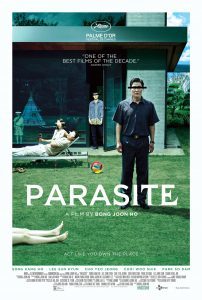
The post An Oscar Winner on The Cinema Scribe appeared first on Brent Marchant.
February 10, 2020
How’d I Do on This Year’s Oscars?
With this year’s Academy Awards ceremony behind us, it’s time to take a look at how I did on my predictions for the winners in this annual competition, as first outlined in my previous blog, “Who Will Win This Year’s Oscars?”, first published on January 24. This was a mixed season for handicapping, some easy, some not. But I was generally pleased with the results, even when I was wrong in my predictions.
So how did I do? Four out of six correct calls, with two misses (and qualified ones at that). Here are the details:
Best Picture

The Field: “Ford v Ferrari,” “The Irishman,” “Jojo Rabbit,” “Joker,” “Little Women,” “Marriage Story,” “1917,” “Once Upon a Time…in Hollywood,” “Parasite” (“Gisaengchung”)
Projected Winner: “1917”
Actual Winner: “Parasite” (“Gisaengchung”)
Result: Missed call (sort of)
This has become the most difficult category to call in recent years, largely because it’s been hard to discern the mind of the Academy voters. What’s more, there were three films actively in the running for this award, based on the results from competitions leading up to the Oscars. Going in, “Parasite,” “1917” and “Once Upon a Time…in Hollywood” all had legitimate shots.
In my predictions blog, I called “1917” the winner for a variety of reasons, not the least of which were its wins in the contests sponsored by the Producers Guild of America and, post-blog, the Directors Guild of America, both of which are often strong predictors of the big prize at the Oscars. However, much to my surprise, on awards night, the statue went to “Parasite,” which seemed more like a dark horse than a shoo-in among the leading contenders.
Not that I’m disappointed with the choice; after all, “Parasite” was my favorite film of 2019. In the weeks leading up to the Oscars, I could see the picture gaining momentum, as evidenced by its win for best acting ensemble at the Screen Actors Guild Awards. But I didn’t think it would build up enough steam in time for the ceremony. Obviously I was wrong about that.
Support for this film ultimately proved to be so strong that it even overcame the projected split that I saw coming in the best picture and best director categories (see below). That’s impressive. What’s more, though, the selection of “Parasite” as best picture represents a significant breakthrough in Academy Award history. It’s the first foreign language film to win the best picture award. It’s also the first Korean film to win the award for best international feature film. That’s quite a number if obstacles to overcome, but it did it successfully – and deservingly so.
But, perhaps most importantly, this film’s win represents a broadening of horizons among Academy voters, a change from the “playing it safe” mindset that has dominated its thinking and choices so much in recent years. Let’s hope that voters keep that up in future years, that they’re more willing to think outside the box than they typically have. They’ve shown here that they can do it – if they so choose.
To my own credit, ahem, I did say that “Parasite” was the nominee that should win. So, given that this ended up being the case, I’ll gladly take a half-credit on this one (because I can!). Maybe I’ll get the mood of the voters right in future years.
Best Actor

The Field: Antonio Banderas, “Pain and Glory” (“Dolor y gloria”); Leonardo DiCaprio, “Once Upon a Time…in Hollywood”; Adam Driver, “Marriage Story”; Joaquin Phoenix, “Joker”; Jonathan Pryce, “The Two Popes”
Projected Winner: Joaquin Phoenix, “Joker”
Actual Winner: Joaquin Phoenix, “Joker.”
Result: Correct call
This was a no-brainer. Phoenix had won virtually everything leading up to the Oscars, and his only serious competition – Taron Egerton for “Rocketman” – wasn’t even nominated. Phoenix thus had a clear path open to him, and he made the most of it, taking home his first statue after four nominations.
Best Actress

The Field: Cynthia Erivo, “Harriett”; Scarlett Johansson, “Marriage Story”; Saoirse Ronan, “Little Women”; Charlize Theron, “Bombshell”; Renée Zellweger, “Judy”
Projected Winner: Renée Zellweger, “Judy”
Actual Winner: Renée Zellweger, “Judy”
Result: Correct call
This was another no-brainer, since Zellweger had been the front runner even before awards season began. She swept all of the major competitions and deservedly so. This was a good choice, the right performer for the right performance.
Best Supporting Actor

The Field: Tom Hanks, “A Beautiful Day in the Neighborhood”; Anthony Hopkins, “The Two Popes”; Al Pacino, “The Irishman”; Joe Pesci, “The Irishman”; Brad Pitt, “Once Upon a Time…in Hollywood”
Projected Winner: Brad Pitt, “Once Upon a Time…in Hollywood”
Actual Winner: Brad Pitt, “Once Upon a Time…in Hollywood”
Result: Correct call
Like the performances in the lead categories, this was another clear-cut winner, though it still boggles my mind how. Pitt swept all of the competitions throughout awards season, so there was no reason why the Oscars should have been any different. I still would have preferred another winner here (any of the other four would do, though Tom Hanks was my favorite), but sometimes the logic of Academy voters escapes me – as it clearly did here.
Best Supporting Actress

The Field: Kathy Bates, “Richard Jewell”; Laura Dern, “Marriage Story”; Scarlett Johansson, “Jojo Rabbit”; Florence Pugh, “Little Women”; Margot Robbie, “Bombshell”
Projected Winner: Laura Dern, “Marriage Story”
Actual Winner: Laura Dern, “Marriage Story”
Result: Correct call
Do we see a pattern here with the acting categories? This was another category that was not difficult to predict, given that Dern had won virtually every other competition (except the National Board of Review) leading up to the Oscars. Again, this award was hers to lose, and it was yet another example of the right performer winning for the right performance.
Best Director

The Field: Martin Scorsese, “The Irishman”; Todd Phillips, “Joker”; Sam Mendes, “1917”; Quentin Tarantino, “Once Upon a Time…in Hollywood”; Bong Joon Ho, “Parasite” (“Gisaengchung”)
Projected Winner: Quentin Tarantino, “Once Upon a Time…in Hollywood”
Actual Winner: Bong Joon Ho, “Parasite” (“Gisaengchung”)
Result: Missed call (sort of)
Like the basis of the 1948 erroneous newspaper headline “Dewey defeats Truman,” my prediction here (as with best picture) was based on outdated information. My prognostication of there being a split in the winners for best picture and director (with the spoils going to “1917” and “Once Upon a Time…in Hollywood,” respectively) was based on information from early on in awards season. However, as noted in my foregoing discussion about best picture, “Parasite” came on strong in recent weeks, not only in the top category but also for best director, enabling it to take both prizes and wiping out the split I projected.
Again, “Parasite” was my preferred choice in this category, despite the fact that I didn’t see it happening, so I’ll take another of those half credits I spoke about earlier.
Oscar® and Academy Award® are registered trademarks of the Academy of Motion Picture Arts & Sciences.
Reviews of some of the winners and nominees are available at the following links:
“A Beautiful Day in the Neighborhood”
Copyright © 2020, by Brent Marchant. All rights reserved.
The post How’d I Do on This Year’s Oscars? appeared first on Brent Marchant.
February 7, 2020
This Week in Movies with Meaning
Reviews of “Les Miserables,” “Clemency” and “Corpus Christi” are all in the latest Movies with Meaning post on the web site of The Good Media Network, available by clicking here.




The post This Week in Movies with Meaning appeared first on Brent Marchant.



